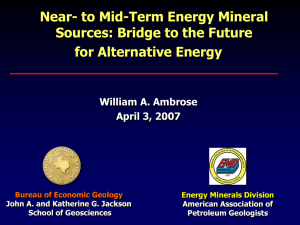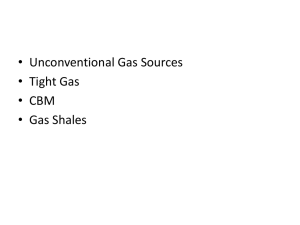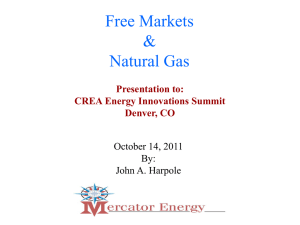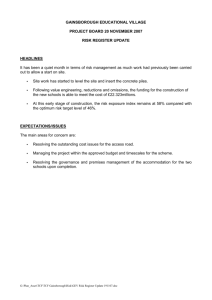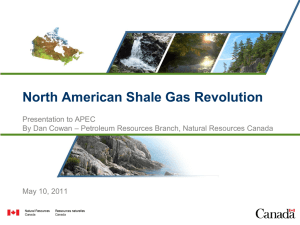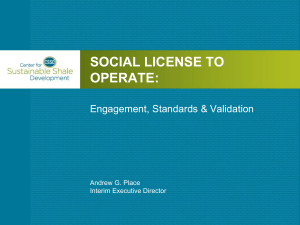US Natural Gas Pipeline Network
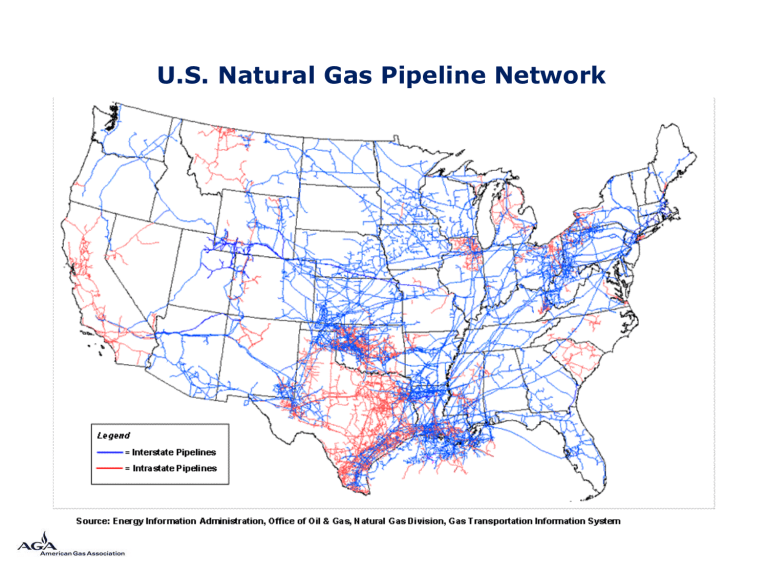
U.S. Natural Gas Pipeline Network
FUTURE NATURAL GAS DEMAND
( 2010-2030)
30
25
20
15
10
5
0
2010
Power Generation
Industrial
Commercial
Residential
Other
2015 2020 2025 2030
Source: Energy Information Administration, Annual Energy Outlook 2009-2030 .
1
FUTURE NATURAL GAS SUPPLY
(2010-2030)
30,00
25,00
20,00
15,00
10,00
5,00
0,00
2010 2015 2020 2025 2030
LNG
Canadian Imports
Domestic Production
Source: Energy Information Administration , Annual Energy Outlook 2009-2030 .
2
35.00
North American Supply
Projected US Supply/Demand Balance
(EIA Annual Energy Outlook 2005)
30.00
25.00
20.00
Initial Alaskan gas reaches lower 48
15.00
10.00
5.00
LNG
Canada
Domestic
Total US Demand
0.00
2005 2006 2007 2008 2009 2010 2011 2012 2013 2014 2015 2016 2017 2018 2019 2020 2021 2022 2023 2024 2025
Year
3
80,0
70,0
60,0
50,0
40,0
30,0
20,0
10,0
0,0
NATURAL GAS SUPPLY
(JANUARY 1-DECEMBER 31, 2008)
LNG
Canadian Imports
Domestic Production
Source : Bentek Energy LLC , Energy Market Fundamentals , December 31, 2008.
4
Shale Basins and the U.S. Pipeline Grid
Source: American Clean Skies Foundation.
U
NCONVENTIONAL
R
ESOURCE
D
EVELOPMENT
Traditional Natural Gas Production
Unconventional
Gas Resources
Shales, Tight Sands,
Coal Seams
Natural Gas Production Barnett Shale 1993-2006
Source: Texas Railroad Commission
General Characteristics of Productive Shales
Source: William Grieser, Halliburton Company.
SHALE GAS RESOURCE ESTIMATES
Potential Gas Committee added about 200
Tcf to U.S. resource assessment between
2004 and 2006 – almost all attributed to new shale-related data
Navigant Consulting, Inc. (2008) estimates
275-842 Tcf from 17 U.S. shale plays
SELECTED SHALE GAS RESOURCE ESTIMATES
Shale Play
Antrim
Appalachian
Marcellus
Haynesville
Fayetteville
Barnett
Lewis (New Mexico)
Lewis (Wyoming)
Estimate (Tcf) Max Gas In-Place (Tcf)
13
70
34
34
76
1744
1500
717
26 52
26
10
14
168
61
98
Mean estimate for U.S. shale resources, 274 Tcf
Gas in-place estimates as high as 3,765 Tcf
(Navigant Consulting, Inc.)
SHALE GAS PRODUCTION ESTIMATES
Depending on the source, some analysts estimate that shale production now at about 5 Bcf per day will grow to 27-35
Bcf per day by the end of the next decade
Will this be additive to current production rates or will it only replace other declining production capability?
Daily Natural Gas Consumption by Sector
January 1-December 31, 2008
100,0
90,0
80,0
70,0
60,0
50,0
40,0
30,0
20,0
10,0
0,0
Pwr Gen
Industrial
Res/Com
Source: Bentek Energy LLC, Energy Market Fundamentals , December 31, 2008.
NATURAL GAS IS BY FAR THE CLEANEST
OF ALL FOSSIL FUELS
250
200
150
100
50
0
N ATURAL G AS P ROPANE G ASOLINE R ESIDUAL O IL W OOD
Source : U.S. Energy Information Administration.
C OAL
13
CONSUMPTION PER RESIDENTIAL
NATURAL GAS CUSTOMER
32% Efficiency
Improvement
Source:
NOTE:
U.S. Energy Information Administration and American Gas Association .
Data is “weather normalized” or adjusted to reduce the impact of abnormally warm or cold weather.
14
70
RESIDENTIAL NATURAL GAS CUSTOMERS
ARE GROWING, BUT THEIR GREENHOUSE
GAS EMISSIONS HAVE DECLINED
300
GREENHOUSE GAS EMISSIONS
NUMBER OF CUSTOMERS
60
250
50
200
40
150
30
100
20
50
10
0
1970
0
2007 1970-1979 2000-2006
Source: U.S. Environmental Protection Agency, U.S. Energy Information Administration and American Gas Association .
15
TOTAL ENERGY EFFICIENCY
(SOURCE ENERGY REQUIRED TO DELIVER 100 MMBtu
TO END-USE CUSTOMER)
400
350
300
250
200
150
100
50
0
E
LECTRICITY
N
ATURAL
G
AS
NOTE: National average electricity generation mix.
16
DIRECT NATURAL GAS USE REDUCES
GREENHOUSE GAS EMISSIONS
17
70
60
50
40
30
20
10
0
NUMBER OF NATURAL GAS
CUSTOMERS INCREASING
1970 2007
18
OUR INDUSTRY’S FUTURE LOOKS BRIGHT
Abundant domestic supply resource base to meet demand growth at reasonable costs
Innovative rate designs to align interests of utility and customers
Increased direct use of natural gas can reduce energy consumption and costs, lower carbon emissions and enhance national energy security
Gas utility industry is a solid, safe, responsible investment
19
Utility Operations Technologies on the Horizon
• Smart Meters
• Expanded Use of Mapping and Other Informational Systems
• Enhanced Locating Technologies
• Improved Leak Detection (Vehicles and Handheld)
• Improved Design, Construction and Materials
• Enhanced Pipeline Repair/Rehabilitation
20

